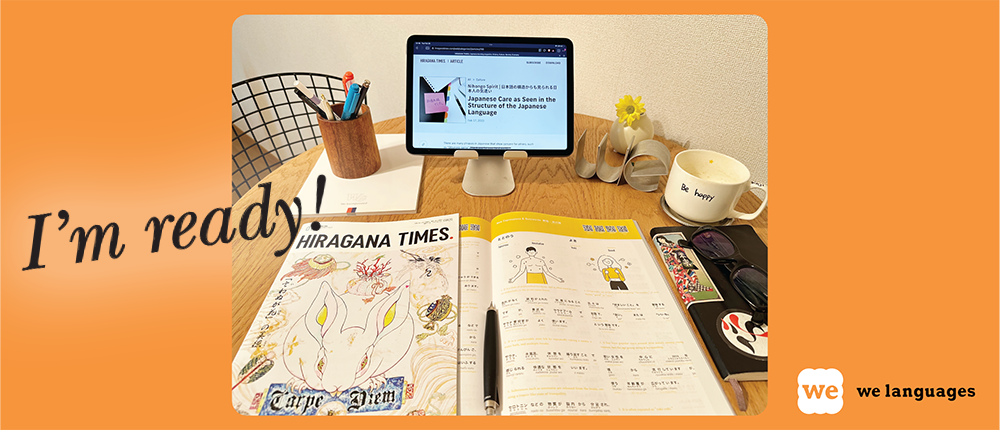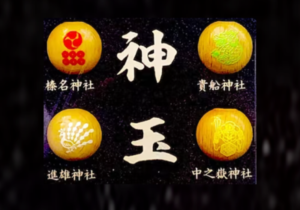「スマートフォンでお読みになる場合は、画面を横向きにすることをおすすめします。」
Weでは、"今流れている~Current Topics~"をもとに、日本語を学ぶ世界の人たちとディスカッションする機会があります。
プロローグ
日本神話には「国生み(くにうみ)」という国土創世の物語があります。「国生み神話」ともいいます。
この「国生み」を、万物創生の根本を為す特別な神々「別天津神(ことあまつがみ)」たちから命じられたのが、伊邪那岐(イザナギ)、伊邪那美(イザナミ)という夫婦の神さまです。
夫婦は、「別天津神」たちから与えられた「天沼矛(あめのぬぼこ)」で「天浮橋(あめのうきはし)」に立ち、渾沌とした地上を掻き混ぜました。
そして矛から滴り落ちたものが積もって「淤能碁呂島(おのごろじま)」となりそれが日本列島の始まりとなります。
このブログで登場する人物「Izanami (いざ波)」と「Izanagi (イザ凪)」はこの日本の神話から由来します。
In Japanese mythology, there is a story of the creation of a land called "Kuni-Umi"(birth of the country). It is also called the "Kuni-umi-Shinwa" myth.
The "Kuni-Umi" was commanded by the "Kotoamatsu-gami (Kotoamatsu-gods)" special deities responsible for creating all things, to a couple, "Izanagi and Izanami."
The couple stood on the "Ameno-ukihashi Bridge" and stirred up the chaos on earth with the "Amenu no Nuboko," a spear given to them by the "Kotoamatsu-gami."
The drops that fell from the spear accumulated to form "Onogoro Island," which was the beginning of the Japanese archipelago.
The story of "Kuni-Umi" is followed by the story of "Kami Umi" (the birth of the gods).
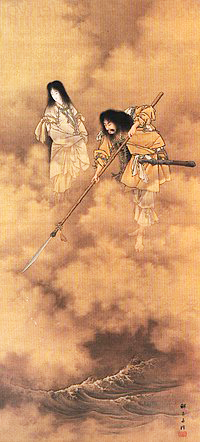
このブログで登場する人物「Izanami (いざ波)」と「Izanagi (イザ凪)」はこの日本の神話から由来します。
The characters "Izanami" and "Izanagi" in this blog are derived from this Japanese myth.
音声を聴いてウォーミングアップ
キーワード
| English | 日本語 | English Example Sentence | 日本語の例文 |
|---|---|---|---|
| unexpected | 予期せぬ | Life is full of unexpected events. | 人生は予期せぬ出来事がいっぱいです。 |
| historical figures | 歴史上の人物 | Many historical figures have faced challenges in their lives. | 多くの歴史上の人物が人生で困難に直面しています。 |
| control | 支配 | He was under the control of a powerful leader. | 彼は強力な指導者の支配下にありました。 |
| plotting | 謀反 | They suspected him of plotting against the government. | 彼らは彼が政府に対する謀反を企てているのではないかと疑った。 |
| commit seppuku | 切腹を行う | He was forced to commit seppuku as punishment for his actions. | 彼は行為の罰として切腹を強いられた。 |
| founder | 開祖 | He is the founder of the tea ceremony. | 彼は茶道の開祖です。 |
| tea ceremony | 茶道 | She learned the tea ceremony from a master. | 彼女は達人から茶道を学びました。 |
| jealous | 嫉妬している | He was jealous of her success. | 彼は彼女の成功に嫉妬していた。 |
| truth | 真相 | The truth about the incident remains a mystery. | その事件の真相は依然として謎のままです。 |
| mystery | 謎 | The disappearance of the painting is still a mystery. | その絵画の失踪はまだ謎のままです。 |
| arrogance | 傲慢 | His arrogance eventually led to his downfall. | 彼の傲慢さが最終的に彼の失墜を招いた。 |
| resignation | 辞世 | She left her resignation phrase. | 彼女は辞世の句を残した。 |
| impermanence | 無常 | The impermanence of life is a common theme in many religions. | 人生の無常さは多くの宗教で共通のテーマです。 |
| masterpiece | 名作 | This painting is considered a masterpiece of the artist. | この絵画はその画家の名作とされています。 |
| transience | 儚さ | The transience of life is a theme often explored in literature. | 人生の儚さは、文学でよく探求されるテーマです。 |
| destiny | 運命 | She believes that her destiny is to become a great writer. | 彼女は自分の運命が偉大な作家になることだと信じています。 |
| teachings | 教え | The teachings of Zen have influenced Japanese culture. | 禅の教えは、日本文化に影響を与えています。 |
| philosophy | 哲学 | Zen is a philosophy that accepts reality as it is. | 禅は、現実をそのまま受け入れる哲学です。 |
| resolution | 解決 | They found a resolution to their conflict through dialogue. | 彼らは対話を通じて彼らの対立の解決策を見つけました。 |
| meditation | 瞑想 | Meditation can help to reduce stress and increase focus. | 瞑想はストレスの軽減や集中力の向上に役立ちます。 |
| enlightenment | 悟り | The master leads his students to enlightenment through questioning. | 師は問いかけを通じて弟子を悟りへと導きます。 |
| essence | 本質 | Understanding the essence of human nature is a lifelong pursuit. | 人間性の本質を理解することは、一生涯の追求です。 |
| calligrapher | 書家 | The calligrapher created beautiful works of art with his brush. | その書家は筆で美しい作品を創り出しました。 |
記事を読んでリーディングスキルをみにつけましょう!
 Izanami (いざ波)
Izanami (いざ波)
人生は予期しない出来事の連続で、国であろうと個人であろうと思い通りにならないのが世の常です。歴史の人物には各自の生きざまが見られます。
Life is a series of unexpected events, and it is always the case that things do not go as expected, whether for nations or individuals. Historical figures have their own way of life.
 Izanagi (いざ凪)
Izanagi (いざ凪)
後に天下人となる徳川家康は織田信長の傘下にあった時代。家康の息子が信長への謀反を企んだという疑いをかけられ、息子は切腹させられました。
TOKUGAWA Ieyasu, who would later become the ruler of Japan, was under the control of ODA Nobunaga. His son was suspected of plotting against Nobunaga, and the son was forced to commit seppuku.
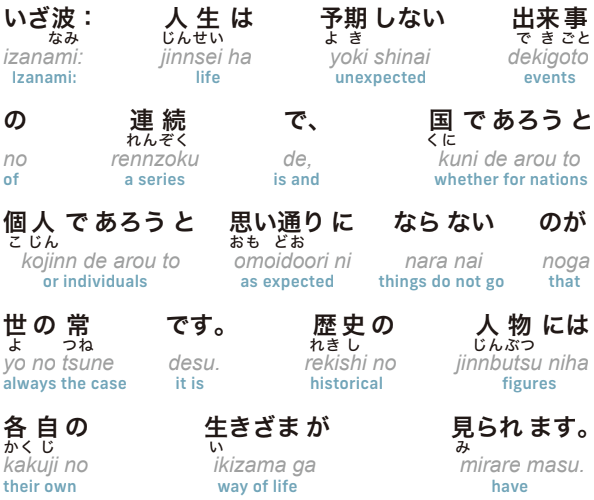
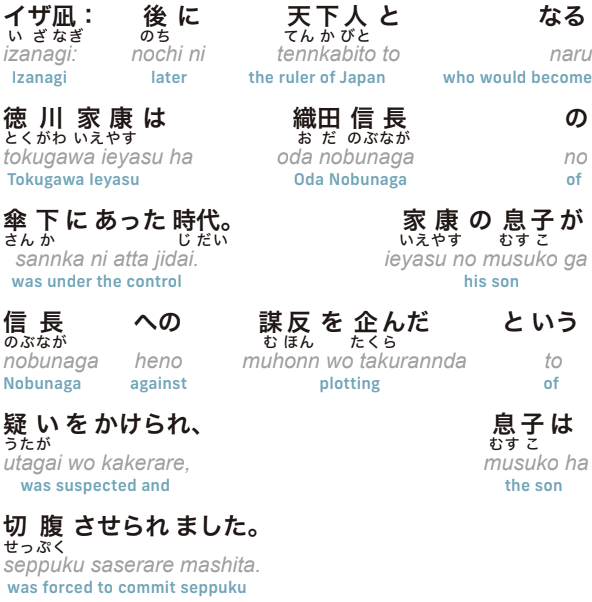
 Izanami (いざ波)
Izanami (いざ波)
茶道の開祖といわれる千利休は、家康の前に日本を統一した豊臣秀吉と互いを理解する間柄でしたが、ある日、その秀吉に突然切腹を命じられました。
SEN no Rikyu, the founder of the tea ceremony, had a mutually understanding relationship with TOYOTOMI Hideyoshi, who unified Japan before Ieyasu, but one day Hideyoshi suddenly ordered him to commit seppuku.
 Izanagi (いざ凪)
Izanagi (いざ凪)
切腹の原因は、文化人に過ぎない利休が、自分以上にもてはやされたことに、秀吉が嫉妬したからとの見方があります。しかし、真相は今も謎のままです。
The reason for seppuku is that some believe that Rikyu, who was nothing more than a man of culture, was praised more than Hideyoshi, which caused Hideyoshi to become jealous of him. The truth, however, remains a mystery.
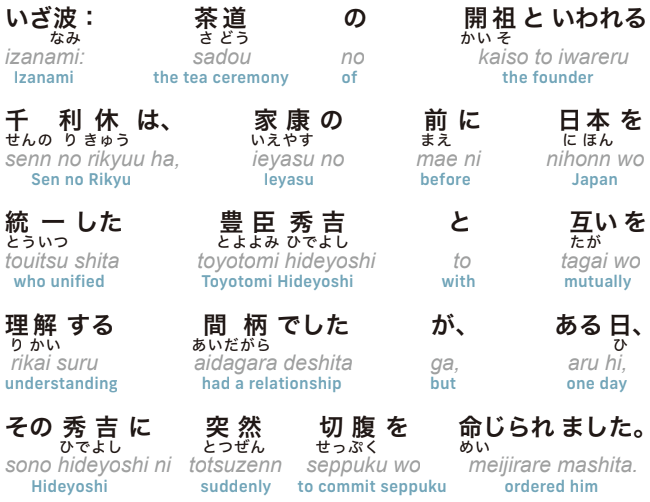
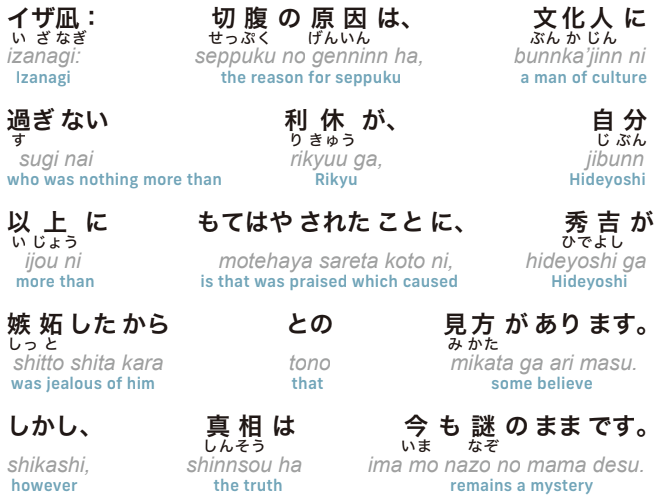
 Izanami (いざ波)
Izanami (いざ波)
利休は反論することもなく、命令を受け入れ切腹しました。権力者の傲慢さを際立たせる利休の沈黙の抗議だったという見方があります。
Rikyu accepted the order and committed seppuku without refuting it. Some believe that it was Rikyuʼs silent protest that highlighted the arrogance of those in power.
 Izanagi (いざ凪)
Izanagi (いざ凪)
戦国武将の妻でクリスチャンに改宗した細川ガラシャは、夫の妨げにならないようにと人質にされる前に自ら死を選びました。
HOSOKAWA Galasha, the wife of a warlord and a convert to Christianity, chose to die so as not to hinder her husband before she was taken hostage.
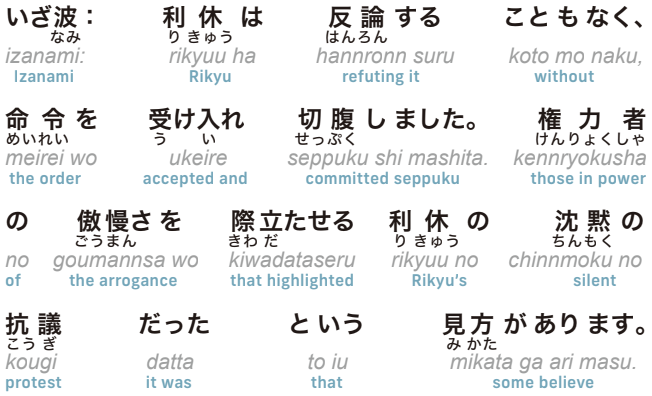
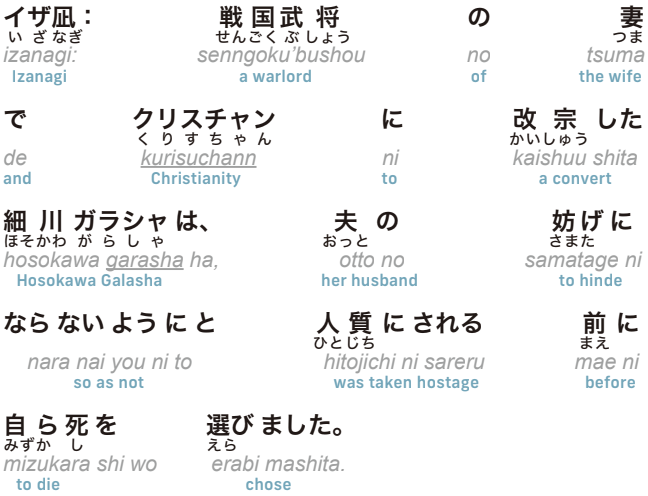
 Izanami (いざ波)
Izanami (いざ波)
彼女の辞世の句は人生をよく言い表しているとして今でも引用されます。「散りぬべき時知りてこそ世の中の花も花なれ人も人なれ」。
Her resignation phrase is still quoted as a good description of human life. She said, “chirinu beki toki shirite koso yononaka no hana mo hana nare hito mo hito nare (People should know when to die, just as flowers know when to fall).”
 Izanagi (いざ凪)
Izanagi (いざ凪)
日本人の死生観は、人も自然の一部とする神道の思想と、世の中に永遠はないという仏教の「無常観」から生まれたといわれます。
The Japanese view of life and death is said to have been born from the Shinto belief that people are a part of nature and the Buddhist doctrine of impermanence, which holds that nothing in the world is eternal.
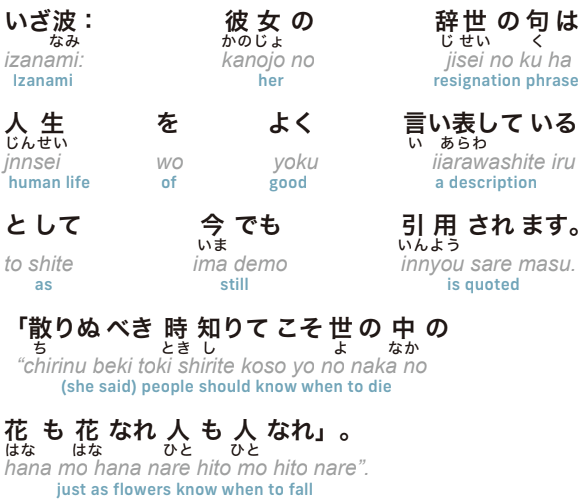
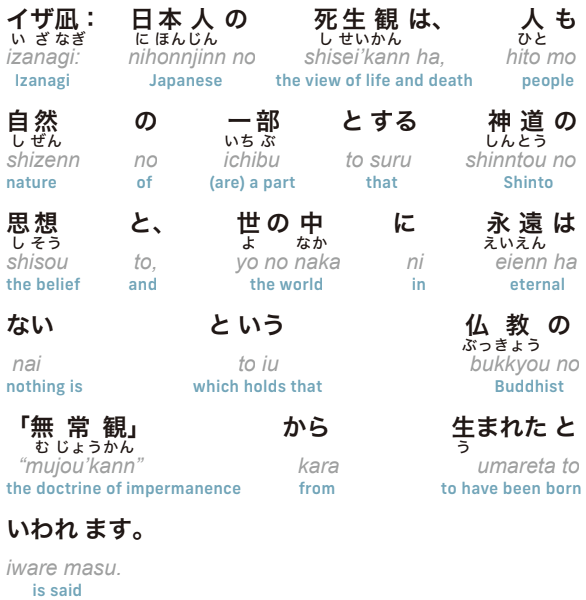
 Izanami (いざ波)
Izanami (いざ波)
平家の栄華と滅亡の過程を描いた「平家物語」や人生を川の流れにたとえた鴨長明の随筆「方丈記」など、世の無常を描いた名作はたくさんあります。
There are many masterpieces depicting the impermanence of the world, such as “The Tale of the Heike” which describes the process of the rise and fall of the Heike clan, and “Hojoki,” an essay that described life as the currents of a river by KAMO no Chomei.
 Izanagi (いざ凪)
Izanagi (いざ凪)
俳句のスーパースターである松尾芭蕉も、人生のはかなさを俳句にしました。「夏草や兵どもが夢の跡」。
MATSUO Basho, the haiku superstar, also wrote a haiku about the transience of life. “Natsukusa ya tsuwamono domo ga yume no ato (Summer grasses, all that remains of warriorsʼ dreams).”
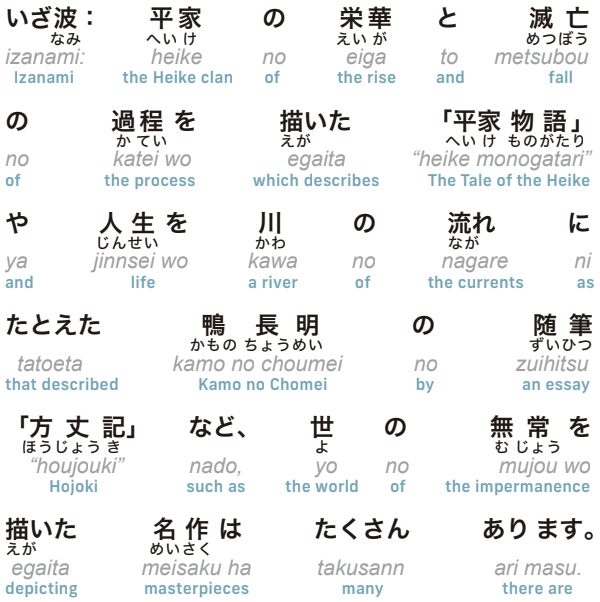
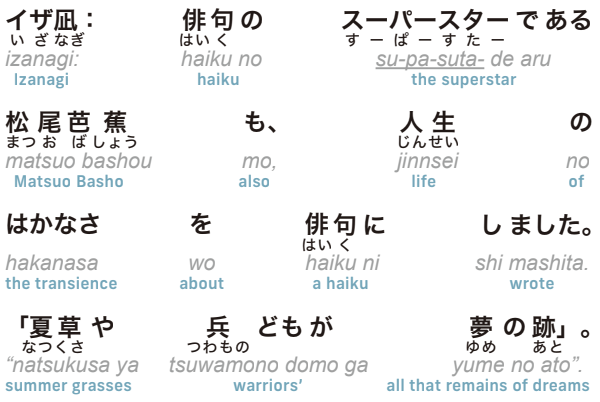
 Izanami (いざ波)
Izanami (いざ波)
女流歌人の与謝野晶子は、こう表現しました。「春みじかし何に不滅の命ぞとちからある乳を手にさぐらせぬ」。
YOSANO Akiko, a female poet, expressed it this way. “Haru mijikashi nan ni fumetsu no inochi zo to chikara aru chi wo te ni sagurasenu (Spring is short, and so I wonder if there exists an everlasting life in this world as I let him touch my breasts full of young strength).”
 Izanagi (いざ凪)
Izanagi (いざ凪)
日本人の根底には、この世のはかなさや運命を受け入れる人生観があります。
At the heart of the Japanese people is a view of life that accepts the transience of the world and one's destiny.
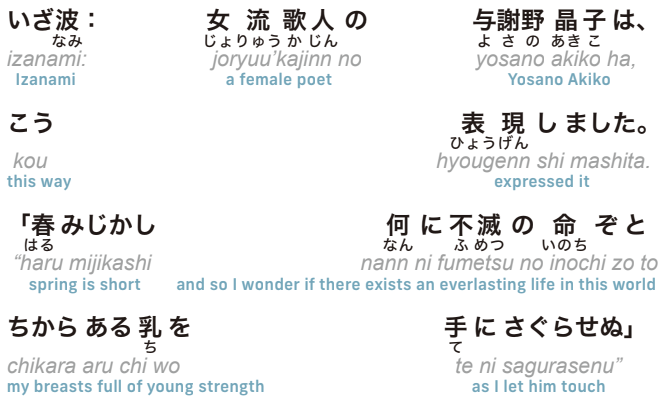
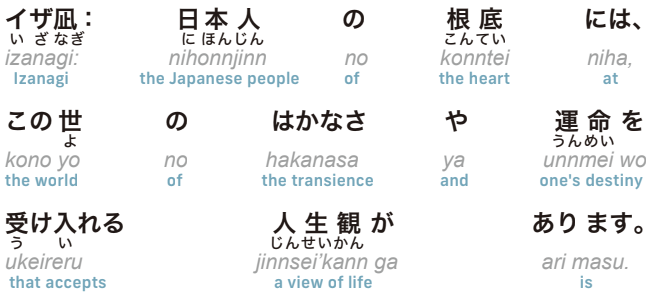
 Izanami (いざ波)
Izanami (いざ波)
これには、日本で開花した禅の教えも影響していると言えるでしょう。禅とはありのままの現実を受け入れる哲学です。
This is due in part to the teachings of Zen, which flourished in Japan. Zen is a philosophy that accepts reality as it is.
 Izanagi (いざ凪)
Izanagi (いざ凪)
禅では、辛いことがあってもそれを受け入れることが解決への道だという自覚をします。
In Zen, we recognize that the path to resolution is to accept whatever is painful.
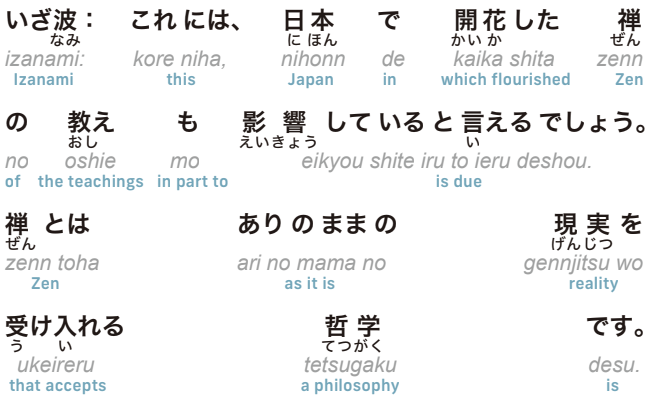
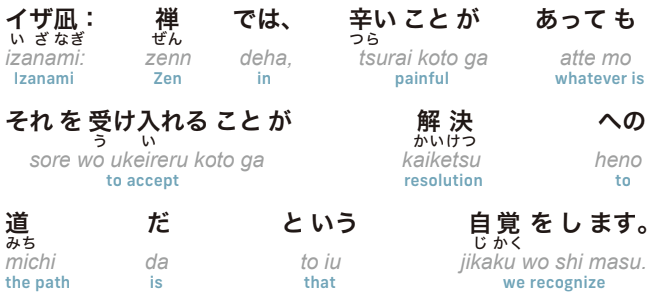
 Izanami (いざ波)
Izanami (いざ波)
禅の修行の主体は座禅と瞑想です。目を半分だけ開け、心は無にして自己が自然と一体であることを実感します。
The mainstay of Zen practice is zazen and meditation. With eyes only half open, the mind is left blank and one realizes that the self is one with nature.
 Izanagi (いざ凪)
Izanagi (いざ凪)
自己が消えても存在するという安心感を得られます。
It provides a sense of security that the self exists even when it disappears.
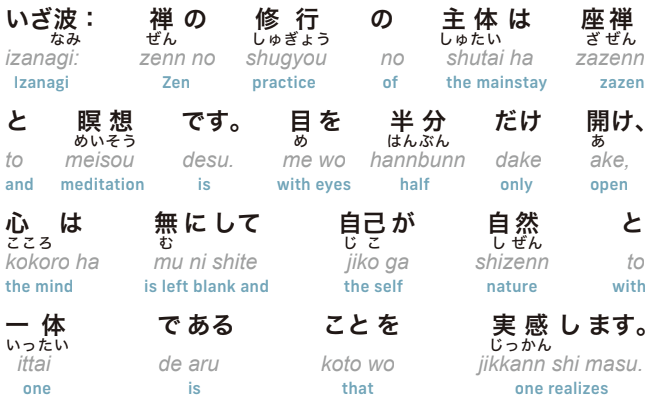

 Izanami (いざ波)
Izanami (いざ波)
ソクラテスは人に討論を持ちかけ、対話によって世の真理を追及しようとしました。
Socrates sought to pursue the truth of the world through dialogue by inviting people to debate.
 Izanagi (いざ凪)
Izanagi (いざ凪)
禅も、師匠と弟子が「生きるとは?」といった問答をすることで悟りに導きます。
In Zen, too, the master leads his students to enlightenment by asking them questions such as “What is life?”
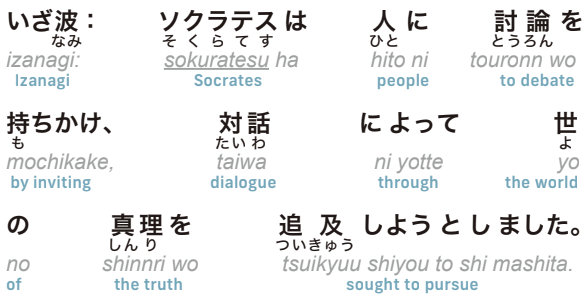
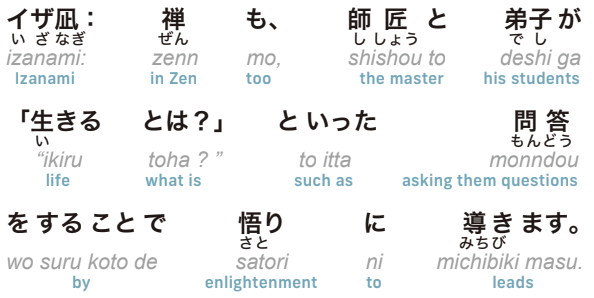
 Izanami (いざ波)
Izanami (いざ波)
現代では、詩人で書家の相田みつをの言葉も、禅が説く人間の本質に通じると言えるでしょう。「つまづいたっていいじゃないかにんげんだもの」。
In this day and age, the words of the poet and calligrapher AIDA Mitsuo can also be said to be in line with what Zen teaches about the essence of human nature. “Tsumaduitatte iijyanaika ningen damono (Who cares if you stumble, we're only human.)”
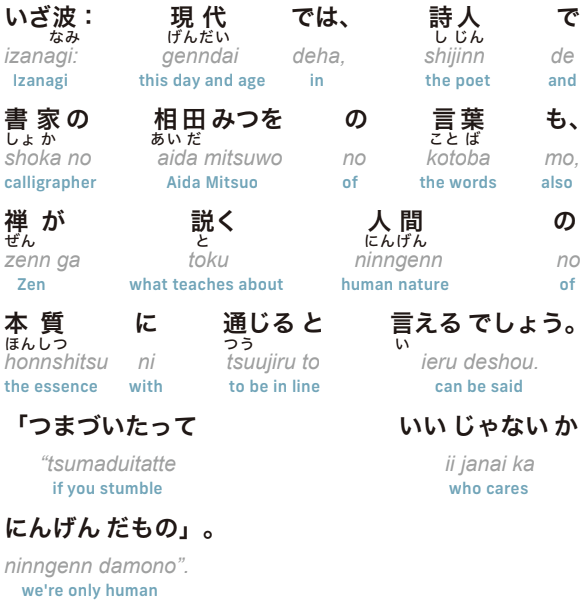
最後に、英語だけで聞いてみましょう!
外国人クラスメイトと共にこの話題で盛り上がりましょう!
「We Languages」では、今流れている"Current Topics"をもとにして英語授業を展開しています。コンテンツパートナーである月刊誌「Hiragana Times」を使用し日本語を学ぶ外国人生徒と同じクラス、同じコンテンツの上でディスカッションするリアルなコミュニケーションの機会が提供されています。リアリティーの中で英語を活用しありのままの日本を英語で説明する能力が高まり真の実力が身につきます。
